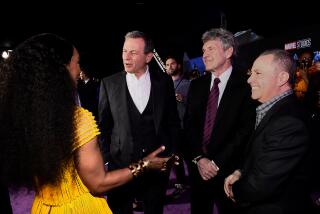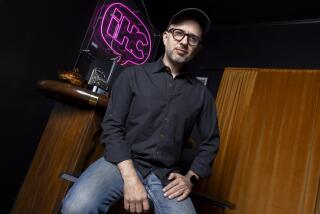Marvel is on a mission
BUILDING a superhero from scratch is noisy and hazardous. “Let’s find a place where it’s quieter!” The man shouting was Kevin Feige, the president of production for Marvel Studios, the Hollywood start-up that takes flight on May 2 with its first film, “Iron Man.” Feige was walking, carefully, through one of the film’s massive Playa Vista sets where a whirling metal saw was kicking up a cascade of bright orange sparks.
Once in a quieter corridor, Feige gushed about its special effects, but then said the greatest asset of the film is a hero with weakness hard-wired into his psyche. “That’s what makes Marvel characters special, they are people who become heroes but also have flaws and they struggle with them,” he said. “Look, the costumes can easily be the stars of these movies if you let them be . . . you have to flesh out the character. They battle bad guys, but they also battle these things within themselves.”
Launching a major movie production company right now seems like a dicey venture. But the Marvel formula has been a spectacular success for other studios the last eight years. The self-doubting Spider-Man, the bickering Fantastic Four, the misunderstood X-Men and all the other Marvel misfits have racked up a stunning $5 billion in worldwide box office, most of that for Sony and Fox. Marvel now wants its own spot at the table. After four years of planning and winning over Wall Street, “Iron Man” is the first step in the company’s quest to go from intellectual-property fount to a stand-alone Hollywood player that can greenlight big-time popcorn movies.
Feige’s boss and friend, David Maisel, chairman of Marvel Studios, is pleased to be standing on the deck of a ship that can go in deep water. “We’re the first since DreamWorks started 14 years ago that can greenlight its own $100 million movies. It doesn’t happen very often.” True, though Marvel is not a studio in the most traditional sense (it has fewer than three dozen employees, no lot, and it will turn to Paramount Pictures as its primary distribution pipeline.)
It makes for an intriguing story arc for the Marvel brand name, which next year celebrates its 70th anniversary. The beginning was not an ambitious one. The year after Superman landed at the newsstands, pulp-magazine publisher Martin Goodman decided to take a flier on this new “comic book” craze. The venture hardly looked like the stuff of history -- the pragmatic Goodman had a fairly low opinion of his newsstand products. “Fans,” Goodman once said, “are not interested in quality.”
Still, that first issue produced two lasting characters, the Human Torch and Namor the Sub-Mariner, and they were soon followed by patriotic World War II creation Captain America. But it wasn’t until the 1960s that Marvel seized on an identity that really mattered in American pop culture. That’s when Stan Lee, Jack Kirby, Steve Ditko and the other creators in the self-styled “House of Ideas” gave the world its first soapy superheroes, masked men who saved the world but somehow lost the girl, bounced their rent check and hid out from the police. Kirby’s art, meanwhile, was so kinetic and surreal that Superman, over at rival DC Comics, instantly seemed like a caped Pat Boone, stiff and slow to understand the new rhythm.
For decades, none of Marvel’s New York-based success story really mattered to Hollywood. Then in the late 1990s a new Marvel boss, Avi Arad, made it his crusade to get his company’s classic heroes on the silver screen. The breakthrough came in the 2000 Fox film “X-Men,” which was deeply loyal to the comic book and starred Hugh Jackman, Halle Berry, Patrick Stewart and Ian McKellen. Its success started a cinematic windfall for all those old Lee, Kirby and Ditko characters, who were belatedly ideal for a moviegoing public in love with CGI wizardry and outsider heroes.
“The intention now,” Feige said with a smile, “is to keep the streak alive.”
That’s easier said than done, especially since Marvel’s most powerful properties have already flown across the screen for other studios. And there’s the savage marketplace realities of today. Why go into the movie-making biz now?
Maisel said the question is the wrong one. “We’re not in the movie business, we’re in the ‘Iron Man’ business right now. Marvel owns the intellectual property. We have an Iron Man video game coming, the toys, the comics, we have an animated television show coming, a direct-to-DVD animated Iron Man movie last year. We’re going to have an Iron Man ride at an amusement park in Dubai in a few years. We have a different perspective.”
‘Amazing confidence’
THE Beverly Hills office of Marvel Studios has been quite the scene in recent months. One afternoon you might see Robert Downey Jr., the star of “Iron Man,” another time it might be Edward Norton, who gets green this June in “The Incredible Hulk.” Edge of U2 has dropped by too, working on the music for Tony-winner Julie Taymor’s planned Broadway musical of “Spider-Man.”
The bright and tidy office has a gleaming statue of the Silver Surfer in its lobby, and in a rear room, behind a locked door, there’s a giant “life-size” image of the new Hulk, who will make his first major appearance this week at ShoWest, the Las Vegas gathering of movie exhibitors. Another wall at the Marvel office is covered with storyboards for the film, including an arctic fight scene between the unjolly green giant and a killer whale. That scene didn’t make it into the film, but maybe it can inspire the ride designers working on that $1 billion Marvel theme park that was announced in March by the Al Ahli Group in the United Arab Emirates.
“All of this, it’s a time of amazing confluence for us,” said Maisel, a former protégé of uber-agent Michael S. Ovitz who also made a career stop at Disney and served as president of Livent Inc., the theatrical production company. Maisel came to Marvel in 2004. Feige, a USC School of Cinema-Television grad, had already been there for four years by then and had worked on the “X-Men” and “Spider-Man” franchises.
The two aspire to take Marvel into the realm of Disney and Pixar as a film brand that speaks to audiences with instant clarity. “I believe,” Maisel said, “we are doing something very special.”
Perhaps, but Marvel Studios will have to do it without its biggest names: Spider-Man, Fantastic Four and the X-Men, as well as Arad, the Marvel executive who trailblazed the path to Hollywood but left the company in 2006. Fox also has the “X-Men” spinoff “Wolverine” (starring Jackman and now filming in Australia) and a possible second one in “Magneto.” Daredevil and Ghost Rider are other fan favorites that have already had their bite at the screen apple.
It’s fair to wonder if Marvel already rented out its best properties to others. That view is supported by the fact that the studio’s second film will be a do-over of sorts -- Ang Lee’s dour “Hulk” was released by Universal in 2003 and didn’t energize audiences or critics (its second week U.S. box office plummeted 70%). The studio has also announced Edgar Wright (“Shaun of the Dead”) will direct “Ant-Man,” a character that dates to 1962 but has gnat-sized name recognition with the public.
Rob Moore, vice chairman of Paramount Pictures, said that doesn’t matter. Marvel has 5,000 characters in its library, and history has shown they don’t need to be household names to click; New Line Cinema, for example, made three successful “Blade” films based on an especially obscure Marvel character.
“Only Pixar has the sort of streak going that Marvel has right now. . . . the stories, both the ones people know and the ones they will learn about, are fantastic,” Moore said. “There’s an awareness when people see the name that, ‘Oh, here comes another movie that I can enjoy as an adult and take my kids to.’ ”
Marvel Studios also has the signature characters Captain America and Thor in active development. Black Panther, Dr. Strange and the Avengers have been circled as other feature film candidates. And the studio is part of a strong company. Marvel Entertainment went public in 1995 at $12 a share; this past week, it was hovering near $25.60.
Still, this is an interesting time to be a new gambler in town. Just over a week ago came the news that New Line Cinema, the studio behind the “Lord of the Rings” franchise, will be gutted and folded into Warner Bros.
In 2005, Marvel Studios secured $525 million in financing with Merrill Lynch, with a strategy to make 10 films in five years with budgets between $100 million and $160 million. But last month, Maisel informed investors that, due to the writers strike, the studio had already been thrown off its plan. There will be only one film next year, and some observers privately say that might not even happen.
Seminal moments
FOR many comics fans, the harrowing opening scene from Bryan Singer’s “X-Men” in 2000 was a Hollywood turning point: The sequence in a Nazi concentration camp announced the sub-genre could take its source material seriously and succeed. But Feige, a bit playfully, said he believes the true pivot point actually came three years earlier.
“I tell people the seminal film that’s responsible for everything that has happened was ‘Batman & Robin,’ ” he said, referring to Joel Schumacher’s infamously bloated 1997 film for Warners Bros. that nearly put the entire sub-genre on ice. “If it hadn’t been so bad, things wouldn’t have gotten so good.”
It was Marvel executive Arad, once a toy designer in Israel, who came to town with the idea of making “serious” comic-book films and putting them in the hands of grown-up fans of 1960s Marvel, such as director Sam Raimi, who had a mural of Spider-Man on his bedroom wall as a kid. Now, the “serious” approach is standard; just look at “Batman Begins,” “300” and “Sin City.” Marvel is keeping pace -- “Iron Man” may be about a guy with a red metal suit, but it stars three Oscar nominees (Downey, Terrence Howard and Jeff Bridges) as well as one winner ( Gwyneth Paltrow). A decade ago, that would have been shocking; now it’s barely noted.
At the Playa Vista set late last year, “Iron Man” director Jon Favreau repeated the mantra that audiences relate best to conflicted heroes. “That’s where the story and the character is,” he said, “but this film has amazing toys too, believe me.”
The story is of Tony Stark, a narcissistic weapons tycoon who enjoys women, booze and the sound of lucrative explosions. But while in Afghanistan (updated from the 1960s comic book, when it was Vietnam), Stark is wounded, kidnapped and forced to design a weapon for the enemies of America. He makes a battle suit that not only helps him escape, it’s a life-support system for a coronary injury.
On the set, Downey, looking muscular and especially sly with a new goatee, made no bones about everyone involved hoping a franchise -- and, by extension, a mainstay studio -- is being born.
“There’s a lot to the story and the character, and the approach now is no longer, ‘Oh, here’s a comic book, this should be mindless,’ ” he said. “This is fun, but we’re also taking it seriously.”
More to Read
The biggest entertainment stories
Get our big stories about Hollywood, film, television, music, arts, culture and more right in your inbox as soon as they publish.
You may occasionally receive promotional content from the Los Angeles Times.






